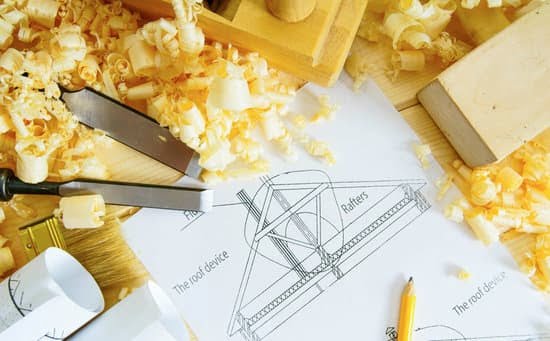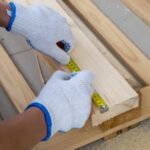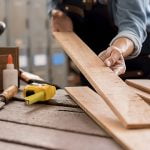So, you’ve decided to take the plunge and delve into the world of woodworking. Congratulations. As a beginner woodworker, one of the first questions you may have is: what is a good selection of tools for beginner woodworking? Starting out can be overwhelming, but having the right tools and equipment at your disposal can make all the difference in your learning journey.
When it comes to woodworking for beginners, having the essential hand tools is crucial. From measuring and marking tools to safety gear, there are certain items that every newbie woodworker should have in their arsenal. Additionally, understanding the importance of selecting the right wood for your projects and familiarizing yourself with basic joinery techniques will set a solid foundation for your woodworking endeavors.
In this article, we will explore the must-have hand tools and power tools for woodworking newbies, as well as safety equipment and gear to ensure a safe and enjoyable woodworking experience. We will also discuss tips for setting up a beginner-friendly woodworking workshop and provide advice on maintaining and caring for your woodworking tools.
Whether you’re interested in crafting small DIY projects or diving into larger furniture pieces, this guide will help you navigate through the basics of woodworking as a beginner.
Essential Hand Tools for Woodworking Beginners
When it comes to starting out in woodworking, having the right hand tools is essential for any beginner. These tools are versatile, easy to use, and can help you develop foundational woodworking skills. The good news is that you don’t need a vast collection of tools to get started – a few key essentials will go a long way.
First and foremost, a good selection of chisels is crucial for any beginner woodworker. Chisels are used for cutting, shaping, and carving wood, making them an indispensable tool in any woodworking project. Look for a set of high-quality chisels in various sizes to cover a range of tasks.
Another essential hand tool for beginners is a set of hand saws. A crosscut saw and a rip saw are great starting points, as they can handle most basic cutting tasks in woodworking. As you advance in your skills, you may want to expand your collection with additional specialized saws.
A sharpening stone or honing guide is also important for maintaining the sharpness of your hand tools. Keeping your chisels and hand saws sharp not only makes your work easier but also ensures cleaner cuts and better results. Investing in quality sharpening equipment will pay off in the long run by extending the lifespan of your hand tools.
Power Tools for Woodworking Newbies
When starting out in woodworking, it’s important to have a good selection of power tools to help make your projects easier and more efficient. Power tools can help you cut, shape, and join wood with precision and speed. Here are some essential power tools that every woodworking newbie should consider adding to their workshop.
Cordless Drill
A cordless drill is a versatile tool that every beginner woodworker should have in their arsenal. Whether you’re drilling pilot holes for screws or assembling pieces of wood together, a cordless drill will save you time and effort compared to using a manual screwdriver.
Circular Saw
A circular saw is great for making straight cuts in plywood, boards, and other large pieces of wood. It’s a handy tool for cutting down large sheets into smaller, more manageable sizes for your projects.
Random Orbital Sander
Once you’ve cut and shaped your wood, a random orbital sander is the perfect tool for smoothing out any rough edges and surfaces. This power tool will ensure that your finished projects have a professional-looking and smooth finish.
Adding these power tools to your workshop will provide you with the necessary equipment to tackle a wide range of woodworking projects as a beginner. As you gain more experience and take on more complex projects, you can consider adding additional power tools to expand your capabilities in woodworking.
Safety Equipment and Gear for Beginner Woodworkers
When it comes to woodworking, safety should always be the top priority. For beginner woodworkers, it’s essential to invest in the right safety equipment and gear to protect themselves from potential accidents and injuries. One of the most important pieces of safety equipment is a pair of high-quality safety goggles. These will help protect your eyes from flying wood chips, dust, and debris that can be produced while working with wood.
Another crucial piece of safety gear is a dust mask or respirator. Woodworking generates a lot of sawdust and airborne particles that can be harmful when inhaled. A good quality dust mask or respirator will help prevent respiratory issues and keep you safe while woodworking.
In addition to eye protection and respiratory protection, beginner woodworkers should also invest in hearing protection such as ear muffs or ear plugs. Constant exposure to loud noise from power tools can damage your hearing over time, so it’s important to take the necessary precautions.
When starting out in woodworking, it’s important to remember that safety should always come first. Investing in high-quality safety equipment and gear may seem like an additional expense, but it is an essential investment for any beginner woodworker looking to pursue their craft safely and effectively.
Must-Have Measurement and Marking Tools for Woodworking
Woodworking involves a great deal of precision and accuracy, making it essential for beginners to invest in the right measurement and marking tools. These tools are crucial for ensuring that your projects turn out as intended, and they can make a significant difference in the quality of your woodworking. Here are some must-have measurement and marking tools for woodworking beginners.
Tape Measure
A tape measure is an indispensable tool for any woodworking project. When selecting a tape measure, look for one with a sturdy locking mechanism and clear markings. A tape measure with both imperial and metric measurements is ideal, as it allows you to work with various types of plans and measurements easily.
Combination Square
A combination square is a versatile tool that can be used for marking, measuring, and checking the squareness of your workpieces. It consists of a ruler and a head that can be adjusted to different angles, making it an essential tool for ensuring accurate cuts and joints.
Marking Knife
A marking knife is used for creating precise, crisp lines on wood, allowing for accurate layout and cutting. Unlike pencils or pens, a marking knife creates a thin incision in the wood fibers, providing a more accurate reference point for sawing or chiseling.
Selecting the Right Wood for Beginners’ Projects
Selecting the right wood is crucial for any woodworking project, especially for beginners. When starting out, it’s important to choose woods that are easy to work with and forgiving for those who are still learning. Some good options for beginners include pine, cedar, and plywood.
Pine is a softwood that is readily available and affordable, making it a popular choice for beginners. It’s easy to work with and has a consistent grain pattern, making it ideal for various projects such as shelves, simple furniture, or decorative items. Cedar is another softwood that is known for its natural beauty and pleasant aroma. It’s also resistant to decay and insect infestation, making it suitable for outdoor projects like garden boxes or benches.
For those looking for a more cost-effective option, plywood is a great choice. It’s made by gluing together thin layers of wood veneer, resulting in a strong and stable material that is perfect for constructing cabinets, bookshelves, or other furniture pieces.
It’s important to consider the type of project when selecting wood as different woods have different characteristics that may affect the outcome of the project. For example, oak is a hardwood that is durable and can be used for items like tables or cabinets. In contrast, maple is also a hardwood but is lighter in color and often used in furniture and flooring.
| Wood Type | Best Projects |
|---|---|
| Pine | Shelves, Simple Furniture |
| Cedar | Garden Boxes, Benches |
| Plywood | Cabinets, Bookshelves |
Basic Joinery Techniques for Beginners
As a beginner in woodworking, it’s essential to become familiar with basic joinery techniques. Joinery is the method of connecting two pieces of wood together to create a strong and durable woodworking project. Without the proper joinery techniques, your woodworking projects may not withstand the test of time. Here are some basic joinery techniques that every beginner woodworker should learn:
- Butt Joint: This is one of the simplest and most basic woodworking joints. It involves joining two pieces of wood by simply butting them together and using nails or screws to secure them in place.
- Pocket-Hole Joinery: Pocket-hole joinery is a fast and simple technique that involves drilling angled holes into one piece of wood and then joining it to another piece using specialized pocket-hole screws.
- Dovetail Joint: Dovetail joints are often considered a hallmark of fine woodworking. They require precision and skill to create, but they result in an incredibly strong and visually appealing joint.
Learning these basic joinery techniques will set you on the right path as a beginner woodworker. As you gain more experience, you can explore more advanced joinery methods such as mortise-and-tenon joints, finger joints, and lap joints.
It’s important for beginners to practice these joinery techniques on scrap wood before attempting them on their actual projects. This will help you perfect your skills and gain confidence in your woodworking abilities. Remember, practice makes perfect.
Setting Up a Beginner-Friendly Woodworking Workshop
Setting up a woodworking workshop is an essential step for beginners who want to start working on projects. Here are some key tools and equipment to consider when setting up your beginner-friendly woodworking workshop:
- Workbench: A sturdy workbench is essential for any woodworking shop. Look for one that is flat, stable, and large enough to accommodate your projects.
- Sawhorses: Sawhorses are versatile and can be used for supporting lumber, as an extra worksurface, or as a base for assembling large projects.
- Storage: Invest in storage solutions such as shelves, cabinets, and tool racks to keep your workshop organized and clutter-free.
- Lighting: Good lighting is crucial for safety and precision in woodworking. Consider overhead lighting as well as task lighting for specific work areas.
It’s important to remember that you don’t need to break the bank when setting up a beginner-friendly woodworking workshop. Focus on acquiring the essential tools and equipment first, and gradually build up your collection as you progress in your skills.
Having a well-equipped and organized workshop will not only make your woodworking projects more enjoyable but also safer and more efficient. By investing in the right tools and equipment from the beginning, you can set yourself up for success in your woodworking journey.
Tips for Maintaining and Caring for Woodworking Tools for Beginners
In conclusion, starting out in woodworking can be an exciting and fulfilling endeavor. As a beginner, it’s essential to have a good selection of tools to help you get started on your projects. From essential hand tools like chisels and saws to power tools such as drills and sanders, having the right tools can make a significant difference in the quality of your work.
One key aspect that beginner woodworkers should consider is investing in safety equipment and gear. Ensuring that you have items like safety goggles, ear protection, and dust masks can help prevent accidents and protect your health while working on your projects.
Additionally, understanding the basics of wood selection and joinery techniques can greatly impact the outcome of your woodworking projects. By learning how to select the right type of wood for your project and mastering basic joinery techniques, you can create strong, durable pieces that will stand the test of time.
Overall, setting up a beginner-friendly woodworking workshop and knowing how to maintain and care for your tools are vital aspects for anyone starting out in woodworking. By following these tips and having a good selection of tools at your disposal, you’ll be well on your way to creating beautiful and functional pieces with confidence.
Frequently Asked Questions
What Is the Most Essential Woodworking Tools?
The most essential woodworking tools include a quality hammer, chisels, hand saws, power drill, and measuring tape. These tools are crucial for basic woodworking tasks and projects.
What Do You Need to Start Woodworking?
To start woodworking, you will need essential tools like a workbench, sawhorses, hand tools (such as chisels, planes, and hand saws), power tools (like a power drill and circular saw), measuring tools (like a tape measure and combination square), and safety equipment (such as goggles and ear protection).
What Is the Most Used Tool in a Wood Shop?
In a wood shop, the most used tool is often the table saw. It is versatile and can be used for various woodworking tasks such as ripping boards to width or cutting them to length. The table saw is considered the heart of many wood shops due to its functionality and efficiency.

Hi everyone! I’m a woodworker and blogger, and this is my woodworking blog. In my blog, I share tips and tricks for woodworkers of all skill levels, as well as project ideas that you can try yourself.





